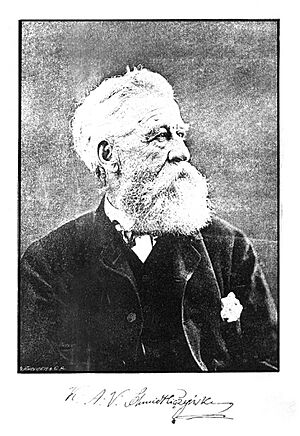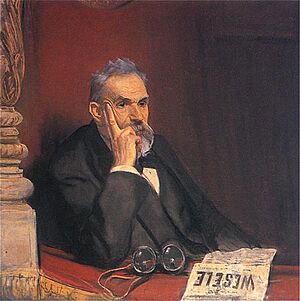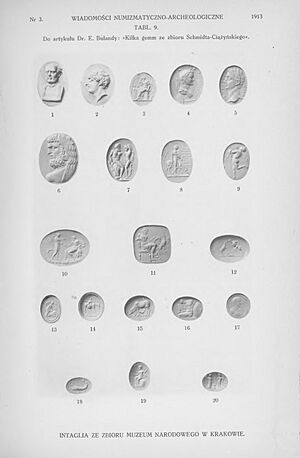Konstanty Schmidt-Ciążyński facts for kids
Konstanty Aleksander Wiktor Schmidt-Ciążyński (born February 18, 1818, died January 5, 1889) was a Polish collector and expert in art. He is famous for donating a huge collection of art to the National Museum in Kraków, Poland.
He probably studied in Dorpat (now Tartu, Estonia). From 1839 to 1851, he lived in Saint Petersburg, Russia. There, he worked at the famous Hermitage Museum. He was a restorer, meaning he fixed old paintings, especially those by Italian masters. During this time, he started collecting his own treasures: engraved gems (tiny carvings on stones), paintings, and prints.
From 1851 to 1859, he became an art dealer in Paris, France. He had a very famous antique shop. He even became an official supplier to the court of Emperor Napoleon III. In 1859, he moved to London, England. There, he slowly sold off most of his collection. He kept only his engraved gems and some of his favorite paintings.
Later in his life, he decided to give his remaining collections to Polish museums. He first thought about giving them to the Polish Museum in Rapperswil, Switzerland. But because of some problems, the collection ended up at the National Museum in Kraków, Poland. This happened thanks to Karol Estreicher. In 1883, an exhibition showed his donated collections in the Kraków Cloth Hall. Today, these items are kept in the National Museum in Kraków.
Contents
His Family and Childhood
Konstanty Schmidt-Ciążyński's father was Louis (Ludwik) Schmidt. He was a doctor from Lorraine, a region in France. He worked as a personal doctor for Empress Joséphine de Beauharnais. Later, he was a doctor in Napoleon I's army. Louis was a very talented person. He was a fencer, an artist, and could play many musical instruments. He also spoke twelve languages! He became a favorite of Napoleon and went with him on several military trips. He was even at the Battle of Somosierra and fought in the war of 1812.
Konstanty's mother was Ludwika Rozalia Ciążyńska. She was from Greater Poland and was known for her beauty. This is why Konstanty later added "Ciążyński" to his last name.
After they got married, his parents first lived in Warsaw, Poland. His father worked as a doctor in military hospitals. He also took part in the Russo-Turkish War in 1828.
Konstanty was born on February 18, 1818. His godparents were important people: Countess Aleksandra Lubomirska and Grand Duke Konstantin Pavlovich. This shows that his parents were well-known in Warsaw.
When he was ten, Konstanty went with his father on trips. He even went on the Eastern campaign during the Russo-Turkish War of 1828–1829. He worked as a dragoman, which means he was an interpreter. He was very good at languages like French, Russian, Turkish, and Ukrainian. This skill helped him a lot later in life.
His Time in Russia
Konstanty studied in Dorpat (now Tartu in Estonia) from 1835 to 1839. However, records don't fully confirm this. He might have been a student there for a short time.
In 1839, he went to Saint Petersburg. He started working at the Hermitage Museum. He was a special employee who could choose his own projects. He could also stop working on them whenever he wanted.
He stayed in Petersburg for 12 years, until 1851. During this time, he became a famous restorer of old Italian paintings. He also became an expert in glyptics, which is the art of carving precious stones. He started his own collection of rare paintings, prints, and many engraved gems. He also bought and sold art to earn money. He traveled around Europe and held an exhibition of prints he had bought. He sold some of them for a good profit. With this money, he bought more ancient art. His collections were worth a lot of money back then.
While in Russia, Schmidt-Ciążyński married a woman named Leontyna. But there isn't much information about her.
In 1851, he became very ill. He quickly sold some of his collection and got 10,000 rubles. He then traveled through England and France to Italy.
Life in Paris
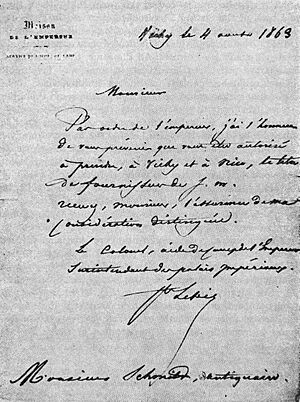
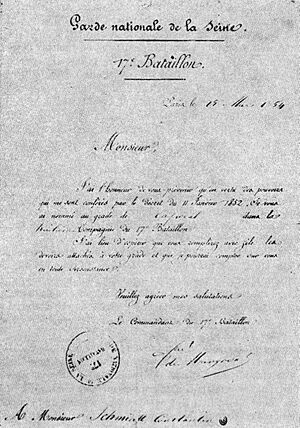
Konstanty lived in France from 1851 to 1869. He arrived in Paris just before Louis Napoleon became Emperor. During this time, many valuable artworks were available cheaply. Their owners were thinking of leaving the city or country due to political changes. Konstanty wisely used his money from Russia. He bought many more items for his collections. He also opened an antique shop called Schmidt Antiquaire. It had branches in Vichy and Nice. His shop became very famous, even attracting kings and queens. In 1863, Emperor Napoleon III himself made Konstanty Schmidt-Ciążyński an official supplier to his court.
While in Paris, on March 15, 1854, Konstanty Schmidt-Ciążyński was also made a corporal in the Seine Department National Guard.
Moving to London
Konstanty Schmidt-Ciążyński lost his only son, who was a talented young man. After this sad event, he left Paris in 1869 and moved to London with his wife. They found a permanent home there. In 1881, the family lived at 24 Trafalgar Square with a servant.
He slowly stopped working in the art business. He sold off most of his collections, keeping only his favorite paintings and engraved gems. Collecting and improving this special collection brought him comfort. Towards the end of his life, he had traveled all over the world. He had no close family left. So, Konstanty Schmidt-Ciążyński decided to give his valuable collections to his homeland, Poland. He said he feared that if he died, his collections would fall into foreign hands. He had spent 50 years collecting them with hard work and all his money.
Donations to Polish Museums
Rapperswil Museum
At this time, Konstanty Schmidt-Ciążyński didn't have direct connections to Poland. In February 1883, he wrote to a friend in Vienna. He asked if there were any museums in Poland. His friend told him about the Polish Museum in Rapperswil, Switzerland. It was founded in 1870 by Count Władysław Plater. On April 6, 1883, Konstanty wrote to Count Plater from London. He offered to donate his collections to the Rapperswil museum forever. He said he was a "loving and grateful son" to the country where he was born. He also asked if he could get a place to live and a small salary from the museum. He offered to help the museum as much as his health allowed.
Without waiting for a reply, he sent paintings, bronzes, and books to Rapperswil. He sent them in two shipments in April and May. He thought his engraved gem collection was too valuable to send by mail. He planned to bring it himself. His arrival depended on Count Plater accepting his conditions.
The items sent to Rapperswil included:
- 43 paintings and drawings by famous artists like Joachim Patinir, Lucas van Leyden, Anthony van Dyck, Lucas Cranach the Elder, Nicolas Poussin, Jean-Baptiste Greuze, Bartolomé Esteban Murillo, Andrea Mantegna, and Titian.
- 106 prints, including 54 by Daniel Chodowiecki.
- 35 bronze objects.
- More than a thousand impressions of cameos and old seals.
Poznań Museum
Around the same time, Konstanty Schmidt-Ciążyński also thought about Poznań. This city was the capital of Greater Poland, where his mother was from. In May 1883, he donated many artworks to the Poznań Society of Friends of Learning. These items are now in the National Museum in Poznań.
This donation included:
- An oil painting by Cesare da Sesto of Madonna with child.
- An oil painting by Bernard van Orley with a similar theme.
- A collection of 132 prints by artists like Rembrandt and van Ostade.
- Four watercolors, possibly portraits of Armenian people.
- A collection of small shells.
Kraków Museum
Also in May 1883, Schmidt-Ciążyński learned about the National Museum in Kraków. He heard about it from Miss Anna Wolska, a friend of Karol Estreicher. The museum had been established in 1879. Schmidt-Ciążyński didn't believe her at first. So, she wrote to Karol Estreicher to convince him to donate his collections to Kraków instead of Rapperswil.
This idea worked! Schmidt-Ciążyński still hadn't received a clear answer from Count Plater about his conditions. So, he decided to give the items he had already sent to Plater to the National Museum in Kraków. He also sent more packages that were ready for Rapperswil to Estreicher instead.
These packages included:
- A painting by Anthony van Dyck, a portrait of Count Digby.
- Two portraits of the Mayor of Haarlem and his wife, probably by van der Helst.
- A painting by Vernet showing the Marseille quayside.
- A painting by Mieris.
- Dozens of watercolors by Rocchi.
- Two watercolors of Madame de Pompadour.
- Books on art history, including old books about engraved gems.

During his talks with Estreicher, they agreed that the engraved gem collection would be valued in Vienna. Experts looked at the collection on July 12, 1883. They said that the collection was so big it could only be compared to the Hermitage Museum in Russia or the museums in Vienna. They made a first agreement for the collection to be given to Kraków. Schmidt-Ciążyński would receive money every year for the rest of his life. In return, his engraved gem collection would belong to the museum. The collection was valued at a very high price.
On August 5, 1883, Schmidt-Ciążyński arrived in Kraków with his engraved gem collection. The collection was first shown to the public in the Kraków Cloth Hall. This was during an exhibition celebrating the 200th anniversary of the Battle of Vienna. The exhibition opened on September 11, 1883. The gems were displayed in special cabinets. Besides gems, other ancient art objects were shown. These included: enamel, Egyptian finds, miniatures, cups, carved stones like Babylonian and Assyrian busts, Phoenician cylinders, Greek and Roman carvings, Egyptian, Greek and Etruscan scarabs, and amulets. There were also ancient rings, Gnostic stones from early Christian times, and religious objects from the Middle Ages. Finally, there were many cameos and intaglios from different periods.
After the exhibition, the gem collection was moved to the Kraków city hall. Then, on April 18, 1884, it returned to the Kraków Cloth Hall.
The city leaders worked to get money from the government to buy Schmidt-Ciążyński's collection. It was very valuable. On April 1, 1885, the city council decided to buy the collection.
On June 19, 1885, an agreement was signed. The engraved gem collection was officially given to Kraków. Schmidt-Ciążyński would receive money every year for his life. The collection had 2,507 pieces and was stored safely. On the same day, another agreement was signed. This one transferred the items previously sent to Rapperswil to the Kraków City Council.
In 1886, the complete engraved gem collection was shown again in the museum. It was placed in a special cabinet. From June 5 to 27, 1886, the museum staff, with Konstanty Schmidt-Ciążyński present, made a detailed list of the collection. It included 2,517 items.
Some people criticized the museum for buying the collection. They said it didn't fit the National Museum because it wasn't related to Polish history. They also claimed that Schmidt-Ciążyński had removed the most valuable pieces before the deal. The museum director, Władysław Łuszczkiewicz, was against the purchase.
Besides the engraved gems, the collection given to Kraków also included 82 paintings and drawings. These were by artists like Jan Brueghel the Elder and Willem van Bemmel.
Count Plater refused to give the items he had received to the National Museum in Kraków. He said that gifts given to the Rapperswil Museum could not be given again to the Kraków Museum. Konstanty Schmidt-Ciążyński argued that he had only intended to transfer the items, and the deal depended on Plater accepting his conditions, which he hadn't done clearly. Plater only accepted these conditions later, in June 1884. But he still refused to return the gifts. So, on December 30, 1886, the city council decided to sue Plater to get the artworks back.
His Death
Konstanty Schmidt-Ciążyński died at almost 71 years old on January 5, 1889. He passed away in Gorizia, Italy, where he lived. He was buried on January 7 in the local cemetery.
He had no close family and didn't leave a will. He left behind more valuable collections of engraved gems, similar to those he had given to Kraków. Later in 1889, other relatives of Schmidt-Ciążyński were found. They agreed that these gems could also be shown in Kraków.
What Happened to the Collection Later
Around 1901 and 1902, the National Museum in the Cloth Hall was reorganized. The engraved gems from the Schmidt-Ciążyński collection were displayed there. Later, as the museum grew, parts of the collection were moved to the Emeryk Hutten-Czapski Museum in Kraków.
Over time, the engraved gems had their original labels and numbers removed. They were then cataloged with other collections. Because of this, some items from Schmidt-Ciążyński's collection are now hard to identify. In the 1950s, the collection was moved to the Department of Artistic Crafts and Material Culture of the National Museum in Kraków. It is still stored there today. This department also has documents about Konstanty Schmidt-Ciążyński's collection and activities.
Studying the Collection
The collection has many different objects from various historical periods and cultures. However, it has not been fully studied as a whole. Only certain types of objects have been looked at closely:
- Professor Joachim Śliwa wrote a book in 1989 about the collection's great scientific value. It describes 155 objects in detail and includes photos. It talks about 50 Egyptian scarabs and 105 so-called magical engraved gems.
- Dr. Barbara Kaim from the University of Warsaw also studied parts of the collection. She looked at seals from the Mesopotamian and Iranian regions. This part includes 104 objects: 24 Mesopotamian cylinder seals, 7 Neo-Babylonian seals, and 73 Sasanian seals.
- In 2011, Krzysztof Ziomko described cylinder seals and stamp seals from Mesopotamia, Iran, Iraq, and other ancient states in his university paper. He also included results from scientific tests like X-ray analysis and electron microscopy on some of these objects.


